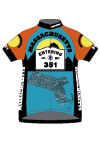History lesson: Chattanooga was a strategic crossroads during the Civil War. Armies needed supplies via railroads or water transport -- Chattanooga had both. Railroads radiated in every direction from town, deep into the heart of the Confederacy. Controlling Chattanooga meant control to the gates to points further south.
The Union army under General Rosecrans manuevered Confederate General Bragg out of Chattanooga, and then started to chase him south into Georgia. But he scattered his forces, and Bragg turned and pounced. The resulting battle of Chickamauga, 10 miles south of Chattanooga, was the second bloodiest of the war, behind only Gettysburg. The Union army was routed and chased back into Chattanooga, where it was besieged.
Enter General Grant. Fresh off his triumph at Vicksburg, he was installed as the new Union head. Grant brought with him his right hand man, Sherman, and gave him control of nearly half his forces. Troops were starving as the Rebels controlled the heights ringing Chattanooga, limiting supplies. Grant's plan -- take the heights, regardless of cost, break the siege, and open the door to Georgia.
The first phase was to capture Lookout Mountain, securing control of the river. Having succeeded there, the following day Grant sent Sherman and his men to crack the tougher nut -- Missionary Ridge, which ran for several miles east of town, including controlling access to the railroads headed to Georgia. A day of bloody fighting, and the job was done. And Sherman's reputation continued to grow.
I really enjoyed my day in Chattanooga. Its Riverwalk was a gem, miles of car free riding. And it was awesome to see couples and families of all types enjoying a sunny day! The 1500' climb up Lookout Mountain was challenging, but the view from the top was worth it!
Chickamauga was sobering and overwhelming. I've been to Gettysburg, there are more monuments here. Monuments EVERYWHERE. And, jumbled in a way that Gettysburg isn't -- the lines ebbed and flowed, so that the patterns aren't clear. What is clear -- the men who fought here, on both sides, believed that what they did on those two days was the most important event of most of their lives. The battlefield is in a rural area, and is maintained in "the condition the men fought in" -- some open fields, lots of densely wooded ground. It felt like a museum covering several square miles -- authentic preservation.
Missionary Ridge -- a different vibe -- it's now an affluent neighborhood, lined with houses, many of which have monuments and cannons in their yards. But the main road is lined with cast iron markers noting where the units fought and statues of the men who fought there. It was sobering to think what courage it took for the Union troops to march up those steep and well-defended heights, cannon and entrenched muskets pointed down at them. Brave men on both sides.
I'll close with my Prequel. I had business this week in Alabama and visited Cullman County. One of my hosts shared that President Trump had held a big rally there last year. I asked why (it was very rural, it seemed like a strange place to hold a rally). "Cullman delivered the highest percentage for him of any county in the US". 88% vote share in the 2020 election.
Which, sparked another "why?" -- and the answer (suggested by James, thanks) -- Cullman was for many years a "sundowning" county -- no blacks allowed by the KKK after sundown. Meaning -- no black residents. Forty years after sundowning stopped, blacks were 1% of county residents in the last census. Patterns run deep and change slowly.
After my meetings ended, I needed to get to the airport to rent a car to drive to Chattanooga. Being me, I rode my bike 12 miles to the airport. My route took me through a black neighborhood. I had ridden through white neighborhoods the previous day, and by comparison, the roads were poorer, the school was closed and padlocked -- this part of Birmingham was not getting the same support. And, I noticed I felt a little uncomfortable -- out of place. A reminder of the discomfort that anyone feels when they "don't look like everyone else around them".
I came back to my hotel tonight and a black man was using the hotel grill to make dinner. I asked him how he was doing, he showed me the Carib pork he was grilling. And -- offered me to try it. I was stuffed from the dinner I had just finished, but told him how much I appreciated the offer (this, btw, is part of what I love about the South -- people really do this in a way that they don't in Boston). Things can change, and we can all get along.

